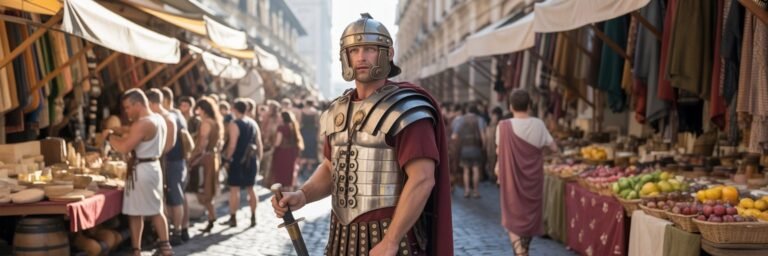INTRODUCTION
At the heart of Italy, Rome stood like a phoenix, stretches of sprawling architecture tucked beneath the azure sky, citizens trudging back and forth along the cobblestone streets. From the surface, Rome was a paradise carefully sculpted by human hands, but beneath its grandiose façade lay an intricate spiderweb of societal norms and everyday life that make Rome a subject of enduring fascination. This article seeks to excavate the remnants of everyday life within the Roman Empire – a life that wasn’t just about conquering lands and erecting monumental buildings but also about the mundane juxtapositions of work, entertainment, food, religion, slavery, and the elusive concept of Roman citizenship.
HISTORICAL BACKGROUND
To accurately depict daily life in the Roman Empire, one must consider the empire’s timeline spanning around five centuries – from 27BC when Augustus became the first Roman Emperor to 476AD when the last Western Roman Emperor, Romulus Augustus, was deposed. This massive expanse of time invariably led to social, political, and cultural evolutions.
In the early empire days, Rome’s elite class was comprised of senators and equestrians, while the lower echelons included slaves, freedmen, and lower-class citizens. Slavery formed the economic backbone of Roman society, shaping almost every aspect of daily life. Slaves served as household helpers, gladiators, miners, or farm laborers and were often treated brutally.
In contrast, Roman citizens enjoyed a variety of jobs: from farmers, soldiers, politicians, to artisans, each had a role to play. As for women, they were largely confined to the household, creating a stark gender divide.
THEORIES AND INTERPRETATIONS
The interpretation of life during the Roman Empire has long been a topic of intriguing academic discourse. The traditional perspective places Rome at the zenith of cultural, political, and social progress, a view promulgated by ancient historians like Livy and Tacitus.
However, other scholars, including the renowned Keith Hopkins, caution the modern observer about idealizing Roman life. Hopkins draws attention to the vast income inequality that pervaded the Roman Empire. This ‘Two Romes’ theory suggests that there was a chasm between the bustling urban culture of the elite and the largely rural existence of the masses, leading to differing everyday experiences.
Another theory revolves around the cultural assimilation within the empire. As Rome expanded, it came into contact with various external cultures, leading to a complex melange of traditions. This ‘Cultural Syncretism’ theory argues that Romans adopted and adapted aspects of the cultures they conquered, ultimately shaping their everyday life.
MYSTERIES AND CONTROVERSIES
The day-to-day life in the Roman Empire is not without its mysteries and controversies. Among the most significant is the role and status of women. While some sources suggest that women had a subservient status, others show instances of women assuming roles as entrepreneurs, doctors, landlords, and even gladiators – a fact fiercely debated by historians.
Controversy also surrounded the practice of slavery. While it’s undeniable that slaves were often mistreated, Roman law also contained provisions recognizing slaves as human beings, capable of earning their freedom, a contrast to the norms in other ancient civilizations.
SYMBOLISM AND CULTURAL SIGNIFICANCE
Everyday life in the Roman Empire was imbued with rich symbolism and cultural significance. A potent symbol was the communal feast or ‘convivium.’ These gatherings, which ranged from modest family meals to extravagant banquets, symbolized unity and underlined social hierarchies.
Roman religion was another essential thread weaving through the daily life fabric. Temples rose in every corner of the empire, their grandeur representing the gods’ potent influence on daily activities. From Vesta, the hearth goddess, whose presence was felt in every Roman home, to Saturn, the god of sowing and harvest, celebrated by farmers, the divine shaped every aspect of existence.
MODERN INVESTIGATIONS
Modern investigations into everyday life in the Roman Empire are shaping our understanding of this period. With advancements in technology, archaeologists can examine artefacts and skeletal remains more precisely, providing a nuanced glimpse into the lives of ordinary Romans.
Digital modeling helps reconstruct entire Roman cities, while DNA analysis sheds light on the empire’s genetic diversity. Recently, a study of Roman latrines unearthed insights into the Roman diet, suggesting it was more varied and balanced than previously thought. Such investigations infuse our understanding of Roman life with fresh perspectives.
LEGACY AND CONCLUSION
The legacy of everyday life in the Roman Empire endures, echoed in Western civilization’s legal systems, languages, architectural styles, and societal structures. The tenets of Roman law continue to inform modern legal doctrine, while Latin, the Roman lingua franca, underpins the Romance languages.
But the legacy transcends tangible aspects – it is the embodiment of a society that straddled the realms of grandeur and humility, striking a chord between the simple pleasures of communal feasting and the spectacle of grand bouts at the Colosseum. As we excavate the layers of time to reveal ordinary Roman life, we glimpse our ancestors navigating their world, just as we do ours, crafting a narrative of human existence that reverberates through eternity.






